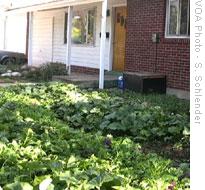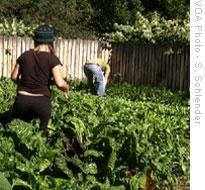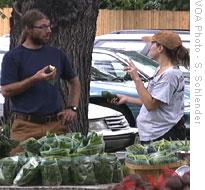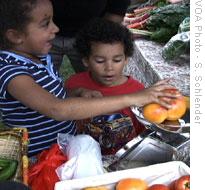VOA标准英语10月-Front-Yard Farmer Turns Lawns into Cropland(在线收听)
In the United States, the typical crop travels nearly 2,500 kilometers from field to table. While U.S. consumers express growing interest in local foods, farmland near urban areas is increasingly unaffordable. These challenges have led a school bus driver who wants to run a local farm to seek a novel solution. He's an urban yard farmer. Shelley Schlender has his story.
 |
| Homeowners allow Kipp Nash to plant crops of his choice in their front and backyards, and Nash harvests what they don't eat |
It's a brisk fall morning in Boulder, Colorado, as Kipp Nash and three assistants stride into their neighbor's backyard garden.
Nash and his team drop crisp green beans in a bucket. They also harvest two dozen bunches of knee-high, satiny Swiss Chard leaves.
They carry bins of chard and beans to Nash's truck. Then they drive past homes with conventional, green grass lawns to gather vegetables in another front-yard garden.
By noon, Nash and his crew will visit 12 front and backyard gardens. They'll gather enough fresh produce for two dozen other neighbors who have paid in advance for the weekly harvest.
 |
| School bus driver Kipp Nash started Community Roots Farm in Boulder, Colorado, three years ago |
Nash, who earns most of his living as a school bus driver, calls this patchwork quilt of garden plots Community Roots Farm. He hopes to build it into a full-time farming career.
"And in the meantime, it's turned into a really, really cool community project," Nash says. "A really neat thing that people can really connect with and source a lot of hope from."
It's a hope throughout the United States, as evidenced by the growing number of local farmers markets, where growers come into a town or city to sell their products to consumers face-to-face. According to the U.S. Department of Agriculture, there are nearly 5,000 farmers markets around the country today - nearly double the number in operation just a decade ago. It's a small but thriving segment of U.S. agriculture, and because farmers can often earn a higher profit dealing directly with the public, it can be a rewarding outlet for the 200,000 American farmers whose fields are only one-half to three-and-a-half hectares in size.
 |
| Assistants help Nash harvest chard and beans from one homeowner's yard |
But even small plots can command big prices, and when Kipp Nash was starting out, he says he couldn't afford anything but his own backyard.
"Then I thought, 'Well, that's not enough to be a farmer.' I wanted to learn how to grow food for market and grow food for community," he says. "So in order to do that, I needed more than just our backyard. And so I thought, 'Well, I'll start checking with the neighbors.'"
So, three years ago, Nash put out the word about Community Roots Farm. He promised to do all the work for front or backyard gardens, as long as the homeowners let him plant what he wanted and let him harvest what they didn't eat. One of his neighbors says it's a wonderful deal.
 |
| Kipp Nash visits with customers as they pick up fresh-from-the-yard produce at the Community Roots harvest booth once a week |
"They actually handle everything, and that's really the nicest thing about it. We don't have to do anything at all," says one woman interviewed by VOA. "I mean if they asked us to, I think we'd be happy to do it. But they really have a great team that handles watering every day. Because when I first moved in I was like, 'Do I need to do anything?' and they were like, 'Absolutely not. Just, you know, leave the fence open for us.'"
Other homeowners say they've been inspired to grow more food themselves.
"He motivated me to do my own garden in my front yard," says another woman. "It's great. It's just so much nicer than grass, and it creates a lot of conversation with people walking by, too."
With a dozen front and backyard gardens, Nash now farms around one-tenth of a hectare. As more neighbors offer yard space in the years ahead, he suspects he'll be closer to half a hectare and closer to a full-time agricultural career.
 |
| Children place vegetables on a scale at the Community Roots harvest booth |
When it's time to pick up their share of the harvest, many of Nash's customers bike or walk to the Community Roots harvest booth set up once a week in a neighborhood parking lot. As they get their fresh-from-the-yard produce, they visit with each other, and Kipp Nash. Nash says it's hard work to run this urban farm, but at times like this, it's worth it.
"Growing vegetables excites me. Pulling carrots out of the earth excites me," he says. "Connecting with my neighbors in a real, earthy way. It excites me. It makes me happy."
Kipp Nash and his Community Roots Farm are part of a growing movement called Community Supported Agriculture. It promotes organic farming, cuts the use of fossil fuels to grow and transport crops, and builds stronger connections between communities and the people who grow their food.